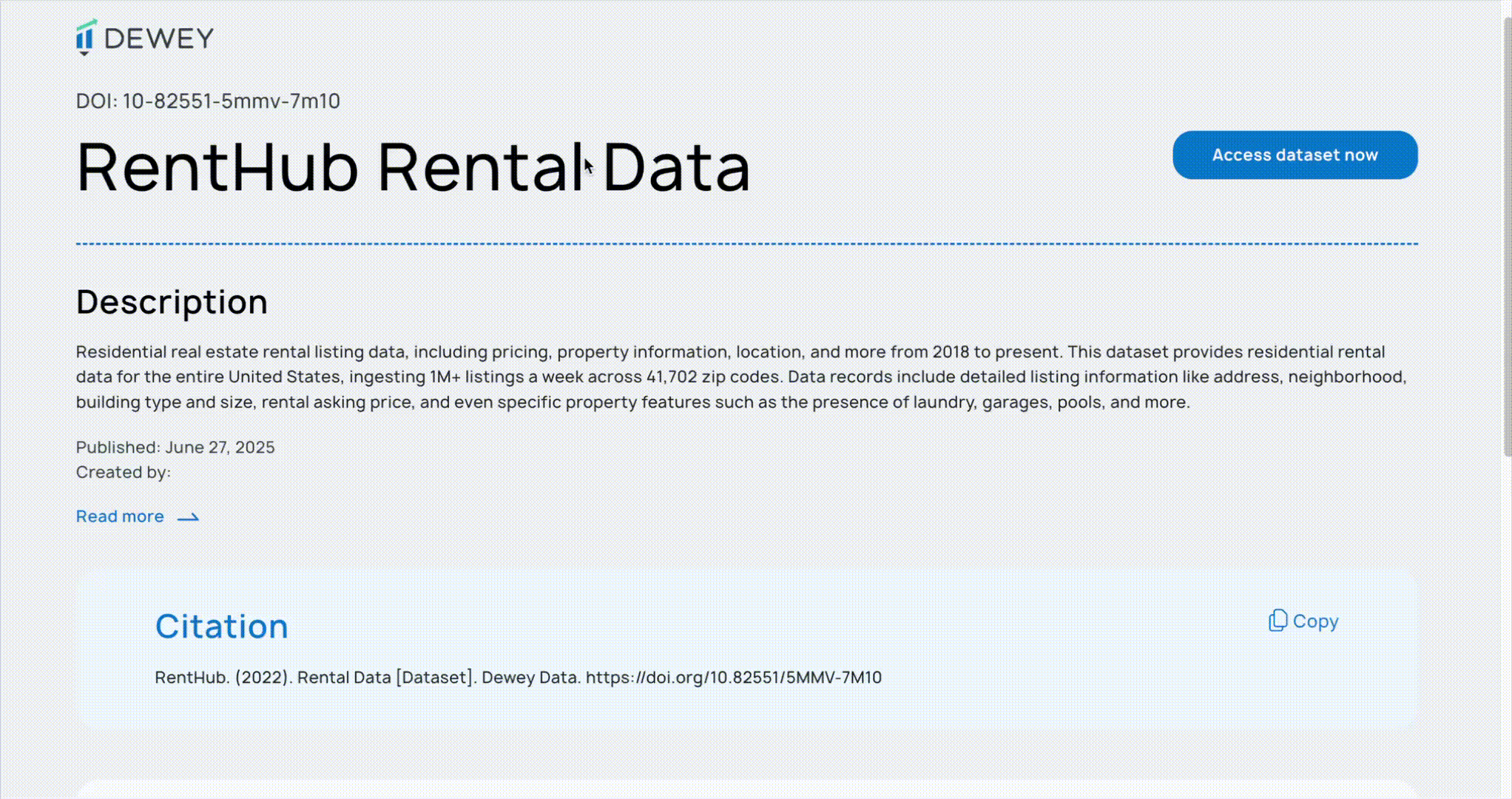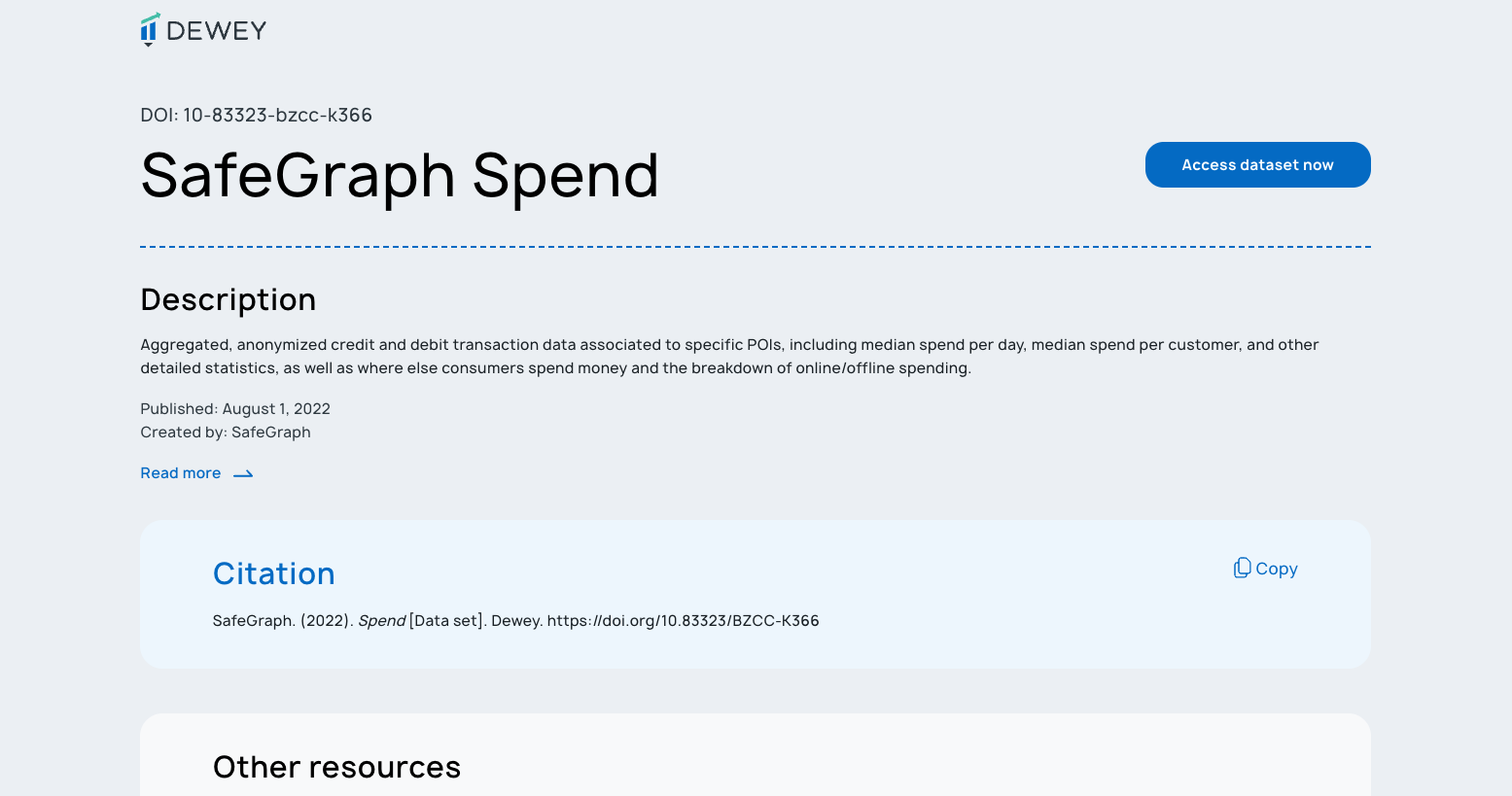Digital Object Identifiers (DOIs)
Everything you need to know about dataset DOIs on Dewey
What is a DOI?
From the DOI Handbook:
A DOI is a digital identifier of an object, any object — physical, digital, or abstract. DOIs solve a common problem: keeping track of things. Things can be matter, material, content, or activities.
A DOI is a unique number made up of a prefix and a suffix separated by a forward slash. This is an example of one: 10.1000/182. It is resolvable using the http://doi.org proxy server by displaying it as a link: https://doi.org/10.1000/182 .
Designed to be used by humans as well as machines, DOIs identify objects persistently. They allow things to be uniquely identified and accessed reliably. You know what you have, where it is, and others can track it too.
DOIs on Dewey
Dewey programmatically assigns Digital Object Identifiers (DOIs) to all primary datasets in its catalog. A primary dataset is defined as one that is essential to supporting research use and interpretation, especially in relation to other associated datasets. For example, SafeGraph Spend Patterns is considered a primary dataset due to its central analytical value, whereas related datasets, such as its Panel Summary, are classified as supplemental because they provide contextual or supporting information but are not independently critical to research outcomes.

Dewey’s DOIs are powered by https://datacite.org/
Versioning
Dewey assigns two DOIs to all primary datasets:
- Concept DOI
- Version DOI
Concept DOIs are minted once per dataset when it is made available on Dewey and represents the dataset across all major and minor version changes. Concept DOIs are:
- Displayed prominently on the dataset page
- Included in the recommended citation
- Included in public-facing informational pages
- Defined in the metadata field
IsVersionOfof Version DOIs
Version DOIs are minted when a dataset is made available on Dewey and when a major version change is made to a dataset. Dewey defines a major version change as a change that makes significant adjustments to underlying or historical data such that it may affect research outcomes. Version DOIs are available on the My Datasets page and in the Concept DOIs metadata in the HasVersion field of the Concept DOI.
Which DOI should I use in my citation?
It is recommended that you use the Concept DOI in your citation, as it persistently identifies the dataset regardless of version, ensuring long-term clarity and consistency in scholarly referencing.
Does Dewey store previous versions?
Dewey does not store previous versions of a dataset if multiple versions are available. Researchers should expect only the latest version to be available through Dewey.
The Version DOI will allow you to see when you have accessed a previous version of a dataset that has since undergone a significant update. This is helpful for understanding replicability.
Will unique DOIs be minted for user-filtered datasets?
No. Filtering a dataset (e.g., selecting specific columns or rows) does not alter the underlying data object. Therefore, the original Concept and Version DOIs remain valid and should still be used in citations.
You can still cite data accessed before DOIs were made available on DeweyDewey launched their DOIs in June 2025. There are no DOIs available for versions before this date. It is still recommended to cite the Concept DOI for a dataset if the data was accessed before June 2025.
Metadata
Dewey writes required and recommended metadata to DataCite, which is publicly available via DataCite Commons and its API. Below are the fields that are provided:
- Creator
- Publisher
- Name
- Publication Year
- Resource Type
- Related Identifiers
- Landing Page
DOIs for datasets on Dewey resolve to public landing pages, ensuring that information on cited datasets is always easily accessible. To dive deeper and explore more about the dataset, visit the Dewey platform.

DOI Landing Page
Metadata for Library resources
Coming soon…
Working with DataCite
Dewey is thrilled to work with DataCite, the global leader in research data identifiers. DataCite’s mission is clear:
“To ensure that research outputs and resources are openly available and connected so that their reuse can advance knowledge across and between disciplines, now and in the future.”
Founded in 2009 as a nonprofit consortium, DataCite is the original and most widely adopted DOI registration agency focused specifically on research data. While other DOI providers cater to journals, books, or software, DataCite is purpose-built for datasets, supporting open infrastructure and metadata standards that make scholarly data shareable, discoverable, and interoperable.
Why DOIs for datasets?
DOIs have long been standard for citing published papers, ensuring persistence, discoverability, and credit. But datasets—a foundational building block of modern research—have often been left behind. This gap hinders transparency and researchers are frequently forced to rely on vague citations, making verification and reuse challenging.
With dataset DOIs, each dataset is individually identified and cited- not just buried in a supplemental appendix. This means:
- Reproducibility: Others can access the exact data used, improving validation and trust in results.
- Discoverability: Datasets become visible and traceable across platforms and citation indexes.
- Impact Tracking: Citations and usage can be monitored over time, just like traditional publications.
In short, dataset DOIs are a key ingredient to unlocking reproducibility, accelerating discovery, and rewarding data creators.
What are the citation requirements?
Dewey's terms and conditions state the following regarding citation requirements:
In any publication, presentation, or publicly shared output that incorporates or is derived in whole or in part from the Licensed Data, Customer agrees to provide appropriate acknowledgment of the original data provider(s) as the producer(s) of the data and Dewey Data Inc. as the platform through which access to the data was provided. Dewey will make available recommended citation formats, and Customer agrees to follow such formats to the extent reasonably practicable
On each primary dataset on the Dewey platform, you'll find the recommended citation. This is currently in APA format. For example:
BrightQuery. (2022). 504 Data [Dataset]. Dewey Data. [https://doi.org/10.82551/6ZNZ-0150](https://doi.org/10.82551/6ZNZ-0150)
At a minimum, this citation should be used within the reference section of the paper. However, it is also recommended to reference Dewey Data and the provider within the Data section of the paper. For example:
This dataset was made available by BrightQuery on the Dewey Data platform.
Updated 6 months ago